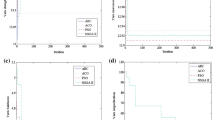Abstract
The quality and cost of resulting yarn play a significant role to determine its end application. The challenging task of any spinner lies in producing a good quality yarn with added cost benefit. The present work does a multi-objective optimization on two objectives, viz. maximization of cotton yarn strength and minimization of raw material quality. The first objective function has been formulated based on the artificial neural network input–output relation between cotton fibre properties and yarn strength. The second objective function is formulated with the well known regression equation of spinning consistency index. It is obvious that these two objectives are conflicting in nature i.e. not a single combination of cotton fibre parameters does exist which produce maximum yarn strength and minimum cotton fibre quality simultaneously. Therefore, it has several optimal solutions from which a trade-off is needed depending upon the requirement of user. In this work, the optimal solutions are obtained with an elitist multi-objective evolutionary algorithm based on Non-dominated Sorting Genetic Algorithm II (NSGA-II). These optimum solutions may lead to the efficient exploitation of raw materials to produce better quality yarns at low costs.






Similar content being viewed by others
References
K. Deb, Multiobjective Optimization Using Evolutionary Algorithms (Wiley, Chichester, 2001)
S. Sette, L.V. Langenhove, Optimising the fibre-to-yarn production process: finding a blend of fibre qualities to create an optimal price/quality yarn. Autex Res. J. 2, 57 (2002)
A. A. Skordos, M.P.F. Sutcliffe, J.W. Klintworth, P. Adolfsson, in Proceedings of the 27th International Conference SAMPE EUROPE, March, Paris, France (2006)
A. Majumdar, S.P. Singh, A. Ghosh, Modelling, optimization and decision making techniques in designing of functional clothing. Indian J. Fibre Text. Res. 36, 398 (2011)
A. Majumdar, V.K. Kothari, A. Mondal, P. Hatua, Optimization of woven fabric parameters for ultraviolet radiation protection, in Proceedings of the 39th Textile Research Symposium, New Delhi, December 2010
M.C. Ramesh, R. Rajamanickam, S. Jayaraman, The prediction of yarn tensile properties by using artificial neural networks. J. Text. Inst. 86, 459 (1995)
L.V. Langenhove, S. Sette, The use of neural nets to predict yarn tensile properties. J. Text. Inst. 87, 400 (1996)
A. Guha, R. Chattopadhyay, Jayadeva, predicting yarn tenacity: a comparison of mechanistic, statistical and neural network models. J. Text. Inst. 92, 139 (2001)
A. Majumdar, P.K. Majumdar, B. Sarkar, Prediction of single yarn tenacity of ring and rotor spun yarns from the HVI results using artificial neural networks. Indian J. Fibre Text. Res. 29, 157 (2004)
K.P. Chellamani, V. Thanabal, A. Basu, T.V. Ratnam, Relationship between USDA calibration cotton properties and yarn strength/unevenness. Indian J. Fibre Text. Res. 29, 12 (2004)
S. Haykin, Neural Networks: A Comprehensive Foundation, 2nd edn. (Pearson Education, Singapore, 2004), p. 161
J.M. Zurada, Introduction to Artificial Neural Systems (Jaico Publishing House, Mumbai, 2003), p. 175
J.H. Holland, Adaptation In Natural And Artificial Systems (University of Michigan Press, Ann Arbor, 1975)
D.E. Goldberg, Genetic Algorithms in Search, Optimization and Machine Learning Reading (Addison-Wesley, Reading, 1989)
N. Srinvas, K. Deb, Multi-objective function optimization using non-dominated sorting genetic algorithm. Evol. Comput. J. 2, 221 (1994)
K. Deb, A. Pratap, S. Agarwal, T. Meyarivan, A fast and elitist multi-objective genetic algorithm: NSGA-II. IEEE Trans. Evol. Comp. 6, 182 (2002)
Author information
Authors and Affiliations
Corresponding author
Rights and permissions
About this article
Cite this article
Ghosh, A., Das, S. & Banerjee, D. Multi Objective Optimization of Yarn Quality and Fibre Quality Using Evolutionary Algorithm. J. Inst. Eng. India Ser. E 94, 15–21 (2013). https://doi.org/10.1007/s40034-013-0015-8
Received:
Accepted:
Published:
Issue Date:
DOI: https://doi.org/10.1007/s40034-013-0015-8



